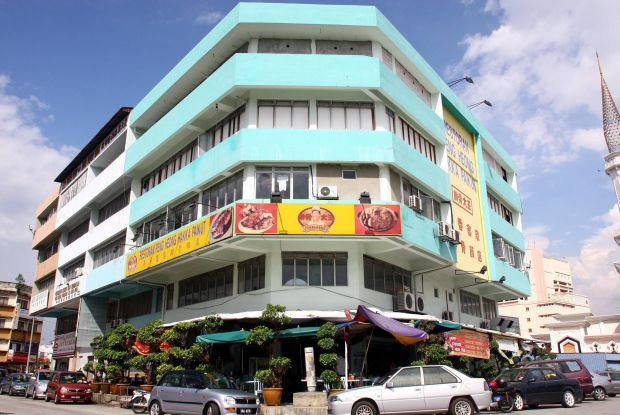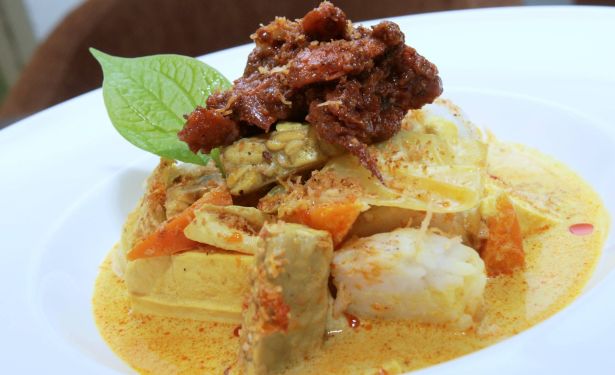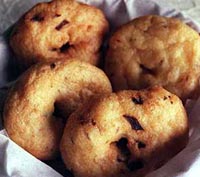The mobile Hakka clan brings more to the table than their adventurous spirit.
IT WAS a journey that started 1,700 years ago. Around 300CE, the Jin Dynasty that controlled a unified China fell apart due to the violent wars between its dukes and princes.
Following the collapse of the central government, the northern nomadic tribes – described as “barbarians” by the Chinese – crossed the Great Wall in great numbers and established strongholds in northern China.
The invaders were ruthless, killing anyone who had ties to the former dynasty. This prompted a mass exodus of northerners, a large number of whom were former court officials, to the south.
There, they encountered another set of problems: Coastal areas, prized for their fertile lands and proximity to a convenient food source (seafood), were already occupied. These political refugees had no choice but to take up residence in the hilly areas of southern China.
Southern Jiangxi, western Fujian and northern Guangdong became popular settlement areas, which grew in size as time went by. Around 1100, this group of people had already become discernable by their culture and language. They became known as the Hakka people. The title, which literally translates to “guest people” in Chinese, is meant to differentiate the group from the native southerners.
Living in wei lou (surrounded residence), a castle-like structure that housed 50 to 60 families at one time, the Hakka people were generally poorer than the Chinese who lived in the coastal areas. Men often left women and children at these residences, while they travelled away from home to make a living.
This is one of the reasons why farmlands were not as abundant in Hakka settlements. Aside from the fact that they lived in hilly areas that were not so easy to cultivate, manpower (quite literally) was not readily available.
This influenced their diet in several ways. According to the Federation of Hakka Associations of Malaysia vice-president Dr Lai Kuan Fook, preserved vegetables became a prominent feature in Hakka cuisine.
“Being rather poor, they ate more vegetables and beancurd than meat – and vegetables were usually preserved so that they could be kept for a longer time,” he explains, adding that this practice reduced wastage, too.
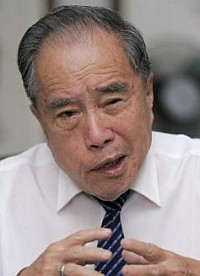 According to Dr Lai Kuan Fook, the frugal Hakka people would mince meat to make it stretch further rather than using whole pieces.
According to Dr Lai Kuan Fook, the frugal Hakka people would mince meat to make it stretch further rather than using whole pieces.“This was necessary because there were no refrigerators then, of course,” says Lai, who is known for his scholarly interest in the history of China. Some of the illustrious posts that he has held in the last half century include head of (then) Mara College’s Chinese language department, Federation of Chinese Association chief executive secretary, and founding president of the Taiwan Graduate Association of Malaysia. Both his parents are Hakka.
Pork, he says, is the preferred meat of theHakkas. This is illustrated by the use of pork as the main ingredient in many traditional Hakka dishes such as Mui Choy Kau Yuk (preserved Chinese cabbage with pork belly) and Hakka Char Yuk (fried pork with fermented tofu; the meat is fried, then stewed with black fungus).
Still, this does not mean that meat was readily available to the Hakka people of yore in China. During their time, meat was considered a luxury and it was usually minced or chopped for everyday use. Lai explains: “If you wanted to use whole pieces to complement rice or noodles, you need a lot of meat. Chopped up, you need less – and it is very easy to spread minced meat across other food.”
In most Hakka homes nowadays, the tradition lives on in the form of steamed minced pork – an easy-to-make dish comprising minced pork and other condiments of choice, such as salted egg, tung choy (a preserved vegetable) or salted fish.
However, though the use of minced meat might have stemmed largely from economical concerns, there is another reason why it was popular among the Hakkas: it was the cooking style of the north.
Lai explains: “It’s best illustrated by the dumplings (called jiaozi in Mandarin) – a northern staple that is made by wrapping ground meat and vegetables in a thin piece of dough.”
Go south
After escaping the harsh persecution in the north, the Hakkas generally stayed put for some time. But this did not last. China was thrown into political and economic turmoil following the 19th century Opium Wars that crippled the ruling Qing Dynasty. The Hakkas, being a mobile bunch, were on the move again.
Lai stresses that this is not an act of cowardice, however. “The Hakka people have always been at the forefront of revolution and military action,” says Lai.
For example, Deng Xiaoping, most renowned as the economic reformer of modern China, is Hakka, cites Lai. So is Lee Kuan Yew, the first Prime Minister of Singapore, and Yingluck Shinawatra, first female Prime Minister of Thailand. This daring and pioneering spirit, says Lai, was what brought them to the tin mines of Malaya.
“The first wave of miners were Hakka and they settled in areas such as Ipoh, Perlis (and other places near the Thai border) and, of course, Kuala Lumpur,” says Lai, adding that one of the most famous of these is Yap Ah Loy, the Chinese Kapitan of KL.
Not surprisingly, culinary traditions were something that this group of people brought with them as well.
For instance, the famous Yong Tau Foo (tofu and vegetables stuffed with a fish or meat paste) is a variation of the original Hakka version, which is made by frying or braising tofu cubes that have been heaped with minced meat.
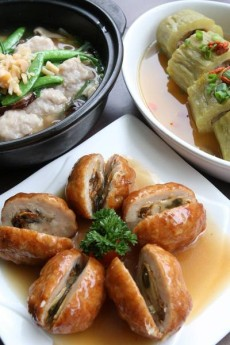 The original: Yong tau foo, in its initial form, is made by frying or braising tofu that has been heaped with minced meat (top left). These days, in can take many different forms such as stuffed bitter gourd (top right) and stuffed oysters(bottom).
The original: Yong tau foo, in its initial form, is made by frying or braising tofu that has been heaped with minced meat (top left). These days, in can take many different forms such as stuffed bitter gourd (top right) and stuffed oysters(bottom).These days, though, just about anything that is stuffed can be considered Yong Tau Foo. Apart from the usual brinjal, bitter gourd and chilli, even fried crullers filled with meat are served at most of the specialty Yong Tau Foo joints.
Hakka Mee – the frugal-looking noodles topped with some sauce, lard, minced meat and spring onions – is another dish that has become popular here in recent years.
Brisk business
Compared with restaurants serving Cantonese-style cuisine – which gave us dim sum, double-boiled soups and char siew (braised pork) rice – restaurants serving Hakka food are few and far between. But the few that are open are doing very good business. An example is Peng Heong Hakka Paikut Restaurant in Klang, Selangor.
Having been reviewed by major Chinese dailies and several TV food programmes, the restaurant, run by William Yong, 53, remains ever popular after 36 years.
It started out as a stall in a food court. Today, Yong has his own corner shoplot with a capacity for 45 tables. A third generation Malaysian Taipu Hakka (Hakkas are further categorised by their area of origin), he beams proudly as he recounts his tale:
“It started with my grandfather who worked as a cook for the English. There, he perfected the skills of making mutton curry and fried pork ribs. I have always been interested in cooking, so I picked up whatever I could from him.”
Though these two dishes are in no way Hakka, they have brought renown to Yong’s establishment. Over the years, he has added a good number of traditional Hakka dishes to his menu. One of the more popular dishes is Red Wine Chicken. This, however, should not be confused with Foochow an ju (red wine) dishes. For one, the thick sauce is not red at all, but a light golden brown.
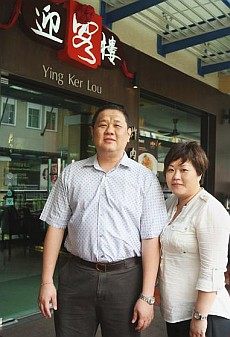 Albert Wee and wife Ng Sook Fun founded the Ying Ker Louchain in 2006 to bring Hakka cuisine to more people.
Albert Wee and wife Ng Sook Fun founded the Ying Ker Louchain in 2006 to bring Hakka cuisine to more people.Yong proudly reveals the secret to the dish: home-made red wine. “It’s difficult to prepare it on your own because, for it to taste good, you’ll have to cook at least two to three chickens at once. This is cumbersome and uneconomical,” explains Yong.
Other Peng Heong specialties include Hakka Char Yuk, Deep Fried Pork Meatballs (made from a secret recipe), and Vinegar Pork Trotters.
And here’s the good news: Eating at Peng Heong is very affordable. A simple meal for two can cost as little as RM10.
“My aim is to make it affordable for all,” smiles Yong.
Peng Heong Hakka Paikut Restaurant is located at No.2, Lorong Gudang Nanas 1, off Jalan Pasar, Klang, Selangor. Call 019-260 0855 or 013-358 1111 for directions. The outlet is open daily from 7am to 4.30pm.

